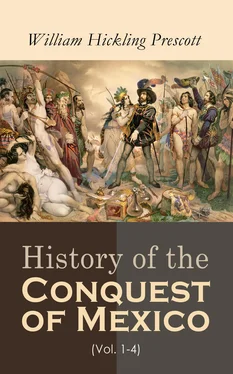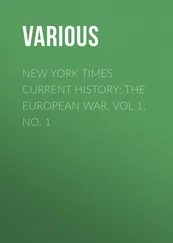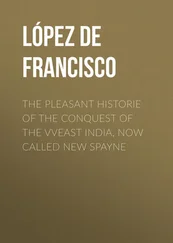The ancient Mexicans made utensils of earthenware for the ordinary purposes of domestic life, numerous specimens of which still exist. [237]They made cups and vases of a lackered or painted wood, impervious to wet and gaudily colored. Their dyes were obtained from both mineral and vegetable substances. Among them was the rich crimson of the cochineal, the modern rival of the famed Tyrian purple. It was introduced into Europe from Mexico, where the curious little insect was nourished with great care on plantations of cactus, since fallen into neglect. [238]The natives were thus enabled to give a brilliant coloring to the webs which were manufactured, of every degree of fineness, from the cotton raised in abundance throughout the warmer regions of the country. They had the art, also, of interweaving with these the delicate hair of rabbits and other animals, which made a cloth of great warmth as well as beauty, of a kind altogether original; and on this they often laid a rich embroidery, of birds, flowers, or some other fanciful device. [239]
But the art in which they most delighted was their plumaje , or feather-work. With this they could produce all the effect of a beautiful mosaic. The gorgeous plumage of the tropical birds, especially of the parrot tribe, afforded every variety of color; and the fine down of the humming-bird, which revelled in swarms among the honeysuckle bowers of Mexico, supplied them with soft aerial tints that gave an exquisite finish to the picture. The feathers, pasted on a fine cotton web, were wrought into dresses for the wealthy, hangings for apartments, and ornaments for the temples. No one of the American fabrics excited such admiration in Europe, whither numerous specimens were sent by the Conquerors. It is to be regretted that so graceful an art should have been suffered to fall into decay. [240]
There were no shops in Mexico, but the various manufactures and agricultural products were brought together for sale in the great marketplaces of the principal cities. Fairs were held there every fifth day, and were thronged by a numerous concourse of persons, who came to buy or sell from all the neighboring country. A particular quarter was allotted to each kind of article. The numerous transactions were conducted without confusion, and with entire regard to justice, under the inspection of magistrates appointed for the purpose. The traffic was carried on partly by barter, and partly by means of a regulated currency, of different values. This consisted of transparent quills of gold dust; of bits of tin, cut in the form of a T; and of bags of cacao, containing a specified number of grains. “Blessed money,” exclaims Peter Martyr, “which exempts its possessors from avarice, since it cannot be long hoarded, nor hidden under ground!” [241]
There did not exist in Mexico that distinction of castes found among the Egyptian and Asiatic nations. It was usual, however, for the son to follow the occupation of his father. The different trades were arranged into something like guilds; each having a particular district of the city appropriated to it, with its own chief, its own tutelar deity, its peculiar festivals, and the like. Trade was held in avowed estimation by the Aztecs. “Apply thyself, my son,” was the advice of an aged chief, “to agriculture, or to feather-work, or some other honorable calling. Thus did your ancestors before you. Else how would they have provided for themselves and their families? Never was it heard that nobility alone was able to maintain its possessor.” [242]Shrewd maxims, that must have sounded somewhat strange in the ear of a Spanish hidalgo ! [243]
But the occupation peculiarly respected was that of the merchant. It formed so important and singular a feature of their social economy as to merit a much more particular notice than it has received from historians. The Aztec merchant was a sort of itinerant trader, who made his journeys to the remotest borders of Anahuac, and to the countries beyond, carrying with him merchandise of rich stuffs, jewelry, slaves, and other valuable commodities. The slaves were obtained at the great market of Azcapozalco, not many leagues from the capital, where fairs were regularly held for the sale of these unfortunate beings. They were brought thither by their masters, dressed in their gayest apparel, and instructed to sing, dance, and display their little stock of personal accomplishments, so as to recommend themselves to the purchaser. Slave-dealing was an honorable calling among the Aztecs. [244]
With this rich freight, the merchant visited the different provinces, always bearing some present of value from his own sovereign to their chiefs, and usually receiving others in return, with a permission to trade. Should this be denied him, or should he meet with indignity or violence, he had the means of resistance in his power. He performed his journeys with a number of companions of his own rank, and a large body of inferior attendants who were employed to transport the goods. Fifty or sixty pounds were the usual load for a man. The whole caravan went armed, and so well provided against sudden hostilities that they could make good their defence, if necessary, till reinforced from home. In one instance, a body of these militant traders stood a siege of four years in the town of Ayotlan, which they finally took from the enemy. [245]Their own government, however, was always prompt to embark in a war on this ground, finding it a very convenient pretext for extending the Mexican empire. It was not unusual to allow the merchants to raise levies themselves, which were placed under their command. It was, moreover, very common for the prince to employ the merchants as a sort of spies, to furnish him information of the state of the countries through which they passed, and the dispositions of the inhabitants towards himself. [246]
Thus their sphere of action was much enlarged beyond that of a humble trader, and they acquired a high consideration in the body politic. They were allowed to assume insignia and devices of their own. Some of their number composed what is called by the Spanish writers a council of finance; at least, this was the case in Tezcuco. [247]They were much consulted by the monarch, who had some of them constantly near his person, addressing them by the title of “uncle,” which may remind one of that of primo , or “cousin,” by which a grandee of Spain is saluted by his sovereign. They were allowed to have their own courts, in which civil and criminal cases, not excepting capital, were determined; so that they formed an independent community, as it were, of themselves. And, as their various traffic supplied them with abundant stores of wealth, they enjoyed many of the most essential advantages of an hereditary aristocracy. [248]
That trade should prove the path to eminent political preferment in a nation but partially civilized, where the names of soldier and priest are usually the only titles to respect, is certainly an anomaly in history. It forms some contrast to the standard of the more polished monarchies of the Old World, in which rank is supposed to be less dishonored by a life of idle ease or frivolous pleasure than by those active pursuits which promote equally the prosperity of the state and of the individual. If civilization corrects many prejudices, it must be allowed that it creates others.
We shall be able to form a better idea of the actual refinement of the natives by penetrating into their domestic life and observing the intercourse between the sexes. We have, fortunately, the means of doing this. We shall there find the ferocious Aztec frequently displaying all the sensibility of a cultivated nature; consoling his friends under affliction, or congratulating them on their good fortune, as on occasion of a marriage, or of the birth or the baptism of a child, when he was punctilious in his visits, bringing presents of costly dresses and ornaments, or the more simple offering of flowers, equally indicative of his sympathy. The visits at these times, though regulated with all the precision of Oriental courtesy, were accompanied by expressions of the most cordial and affectionate regard. [249]
Читать дальше












